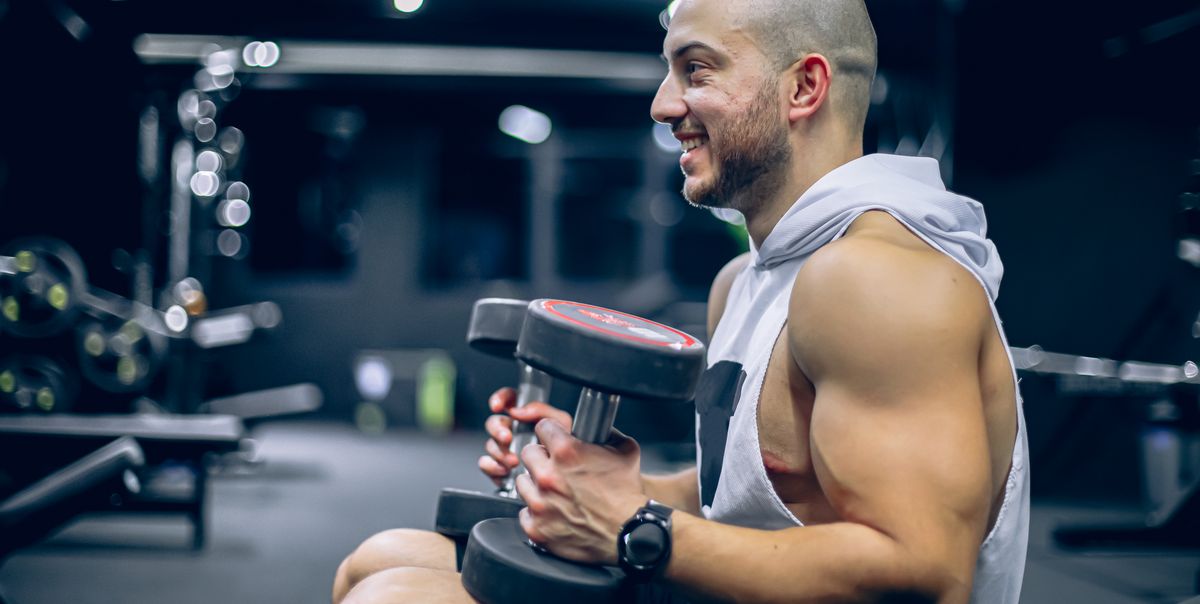There tends to be two camps when it comes to arm training: bicep curls every day, or those who always choose to hit their biceps indirectly with compound lifts. But according to exercise scientist and hypertrophy researcher Dr Milo Wolf, both camps might be missing the mark.
‘Your triceps are about two and a half times bigger than your biceps,’ Dr Wolf explains in a new YouTube video, ‘and your elbow flexors include more than just the biceps.’ That means the classic approach of a few curls and pushdowns simply won’t cut it for gaining as much mass as possible. To optimise your arm training he gives his best tips, backed by 32 studies.
The Muscles of the Arms
VectorMine//Getty Images
To train your arms properly, you need to understand the full anatomy. ‘The biceps flex the shoulder, flex the elbow and supinate the wrist,’ says Dr Wolf. But they’re only part of the picture. ‘The brachialis and brachioradialis actually make up about half of the elbow flexor muscle volume. If you’re only doing a biceps curl that hits your biceps and neglecting the brachialis and brachioradialis, you’re leaving over 50% of your growth potential untapped for the elbow flexors.’
Your triceps are often overlooked, says Dr Wolf, ‘They do the opposite of the biceps: they extend the elbow and also extend the shoulder if you’re looking at the long head. So you’ll want to train the long head of the triceps in a stretched position as well, to make sure that you grow that part of your arms properly.’
The Best Arm Exercises
Dr Wolf’s preferred exercises are based on targeting each head through its full range of motion, with a bias toward loading muscles in the stretched position, which is something studies show enhances hypertrophy.
‘My go-to exercises for the biceps include something that emphasises a stretch on the biceps, such as an incline curl or bench cable curl. I’ll then often do a hammer preacher curl or a preacher curl variation to target the brachialis and the forearms. And then optionally, I’ll do a supinating dumbbell curl or a concentration curl to focus a bit more on the wrist supination aspect of biceps training.’
His triceps training follows a similar structure: ‘I would do an overhead triceps extension like an overhead cable triceps extension or overhead dumbbell triceps extension to train the long head in a stretch position. I’d also do a lying triceps extension, like a skull crusher or JM press, and optionally a close-grip bench press, which tends to grow the triceps quite well – though it’s not quite as good as the other two for hypertrophy.’
How Many Sets Do You Actually Need?
Volume depends on your broader training split. ‘If you’re doing 20 sets of pressing and pulling each week, that’s already about 10 sets for your arms passively. You might then add in 10 sets for biceps and 10 sets for triceps, bringing the total up to 20. That’s quite reasonable for most people.’
For those looking to push growth further, you’ll need to spread volume across the week. ‘If you’re looking to specialise in arms and you want to do 30 to 40 sets per week per muscle, you’ll have to spread that out across three to four days per week. A good rule of thumb is that for every 10 fractional sets you do for a muscle, add in an extra training day for that muscle. So if you’re training arms with 20 sets per week, train them twice. Thirty sets per week? Train them three times. Forty sets? Train them four times.’
LordHenriVoton//Getty Images
How to Train for Muscle Growth
It’s not just how much you train, it’s how you execute it. Dr Wolf recommends staying close to failure without burning out early.
‘I take the first set one to two reps shy of failure. Then on the last set, I either take it to failure or even past failure using partials in the lengthened position. For example, if I’m doing an overhead triceps extension, I’ll do partials out of the stretch to overload that position a bit more,’ says Dr Wolf.
Progression is just as important. ‘My go-to progression for arms is simple: double progression on the first set. So if I’m doing a biceps curl for 3 sets of 10 to 15, I’ll use a load that allows me to get 10 to 11 reps on the first set. Once I get to 15 or more reps, I increase the weight next session. The second and third set might stay the same rep-wise – that’s fine. What I care about is progressing that first set.’
Save Time With Supersets
If your schedule’s tight, there’s no need to skip arms. ‘Supersetting the biceps and triceps, or just supersetting triceps with themselves. For example, doing one triceps exercise and then another is a great way to get more work done. In fact, there’s some research showing that supersetting the biceps and triceps, as opposed to doing them sequentially, led to similar growth while shaving up to 40% time off your workout.’
Don’t Let Form Undo Your Effort
Dr Wolf finishes with the biggest mistake he sees when it comes to arm training: poor technique. ‘People drag curl, which shortens the range of motion and emphasises shoulder flexion rather than elbow flexion. People often flare the elbows out too much during triceps training. And people don’t go deep enough into the stretch. Don’t stop at 90 degrees like you’re afraid of the full stretch. Actually use the stretch to your advantage, especially for the triceps and biceps,’ he concludes.
Related Stories
